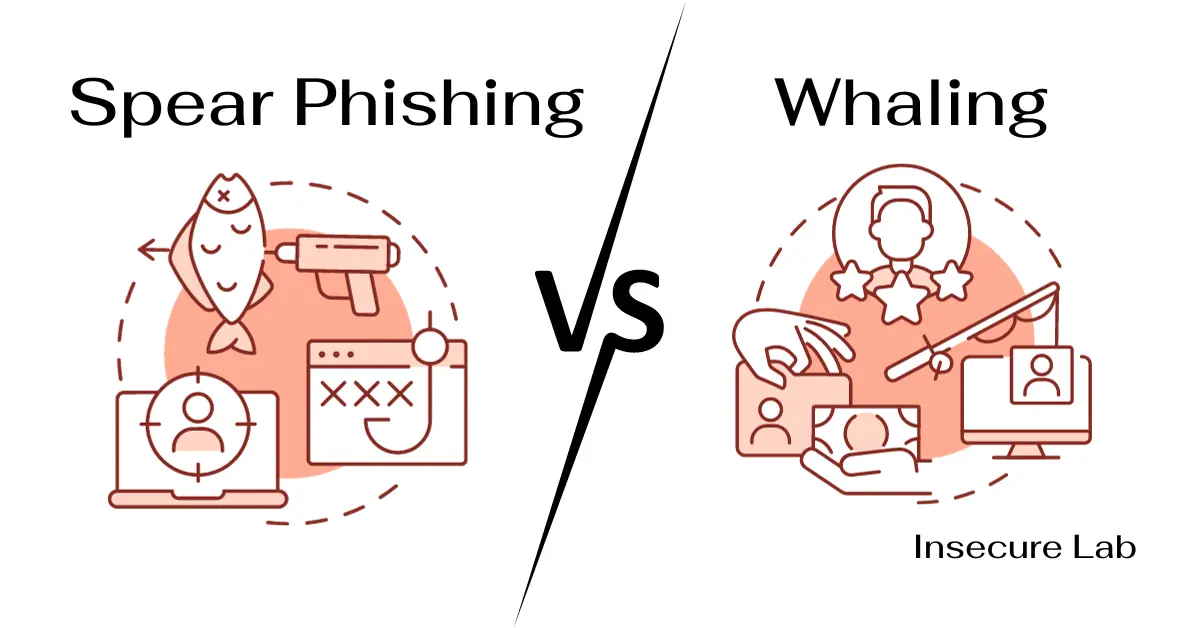Table of Contents
This ethical hacking guide explores the key differences between spear phishing vs whaling attacks on various aspects of cyber security.
Spear Phishing and Whaling
Spear phishing and whaling are both targeted forms of phishing attacks that are used by cyber criminals to trick individuals into revealing confidential information or installing malware.
Although they have similarities, the main difference lies in their goals and execution strategies. Here, we’ll explore both attacks in depth, examine their impacts, and provide strategies for protection.
What is Spear Phishing?
Spear phishing is a targeted form of phishing attack where the attacker targets specific individuals or organizations. The attacker often gathers personal information about their target in order to create a more convincing lure. The goal is often to steal sensitive information or install malware on the victim’s system.
Characteristics
- Highly Targeted: Directed at specific individuals or companies.
- Personalized: Uses information about the target to increase the chances of success.
- Mediums: Email, social media, or any digital communication platform.
- Objective: Stealing sensitive data, installing malware, or conducting espionage.
Example
An employee at a tech company receives an email that appears to be from the IT department. The email addresses the employee by name, references a specific project they are working on, and asks them to click on a link to update their password. This email is actually from an attacker who has gathered specific information about the employee to make the phishing attempt more convincing.
What is Whaling?
Whaling is a specific type of spear phishing that targets high-profile individuals such as CEOs, CFOs or other executives. These attacks are highly customized and often involve extensive research on the target in order to appear as legitimate as possible. These attacks are also known as “Executive Phishing” or “CEO fraud” or “Business Email Compromise”.
Characteristics
- Targets High-Profile Individuals: Focuses on senior executives or important figures.
- More Sophisticated: Often involves more detailed and convincing campaigns.
- Objective: Typically for financial gain or significant data breaches.
- Execution: May involve complex schemes, including fake legal subpoenas or urgent business matters.
Example
The CEO of a company receives an email that appears to be from a trusted vendor. The email discusses a recent, real meeting the CEO had and mentions specific details. It then requests an urgent wire transfer to finalize a supposed deal discussed in the meeting. The email is actually from an attacker using gathered intelligence to trick the CEO into transferring funds.
Spear Phishing vs Whaling
Both attacks involve targeted phishing emails, but they differ in their targets and goals.
Difference Between Spear Phishing and Whaling
The table below provides an overview of the key differences between whaling vs spear phishing attacks on various aspects.
| Aspect | Spear Phishing | Whaling |
|---|---|---|
| Target | Individual employees or specific groups within an organization. | High-profile individuals such as executives, CEOs, or celebrities. |
| Goal | Steal sensitive information like login credentials, financial data, or intellectual property. | Gain access to highly confidential information, conduct corporate espionage, or cause reputational damage. |
| Attack Surface | Targets a broader range of employees or departments based on the attacker’s reconnaissance. | Focuses on a single, high-value target. |
| Personalization | Emails are often personalized with information gathered from social media, corporate websites, or other sources. | Highly personalized emails with specific details about the target’s personal or professional life. |
| Impersonation | The attacker may impersonate a coworker, supervisor, or trusted entity to increase credibility. | Impersonates a top-level executive or a figure of authority to exploit trust and authority. |
| Complexity of Scheme | Varied, but generally less complex than whaling. | Highly complex, often involving deep knowledge of the organization’s hierarchy and internal processes. |
| Typical Content | Emails mimicking internal communications, requests for information, or login credentials. | Fake legal documents, urgent financial transactions, or confidential business matters. |
| Example | An email from a ‘colleague’ asking to confirm login details for an internal system. | An email mimicking a legal subpoena or an urgent request for a financial transaction from the CEO. |
Prevention Methods
- Education and Awareness: Regular training for employees on identifying phishing attempts.
- Email Verification: Implement email authentication protocols like SPF, DKIM, and DMARC.
- Anti-Phishing Tools: Use email filtering and web security solutions.
- Financial Protocol: Establish strict financial transaction protocols, especially for unusual requests.
- Executive Training: Specialized training for executives and administrative staff on recognizing whaling attempts.
- Information Sharing: Be cautious about how much personal and professional information is shared publicly, as attackers use this for crafting attacks.
- Incident Response Plan: Have a plan in place for responding to successful attacks.
Conclusion
While both spear phishing and whaling are sophisticated forms of cyber attacks that rely on social engineering, whaling is particularly dangerous due to its focus on high-value targets and potential for significant organizational damage.
Organizations should educate their employees about these threats, especially those in high-profile positions, and implement strong security protocols to mitigate risks.
Regular training, advanced email filtering, two-factor authentication, and a culture of security awareness are essential in protecting against these targeted attacks.

